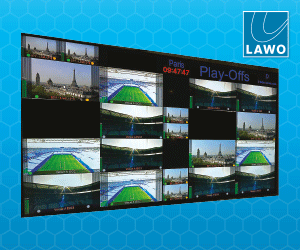The social TV phenomenon is gradually gaining traction in the region and has the potential to change the dynamics of the broadcast industry if executed appropriately. In an exclusive interview with BroadcastPro ME, Chris Wyatt, one of the founders of the social TV phenomenon and CEO of Youtoo, speaks about how broadcasters can actively […]

The social TV phenomenon is gradually gaining traction in the region and has the potential to change the dynamics of the broadcast industry if executed appropriately. In an exclusive interview with BroadcastPro ME, Chris Wyatt, one of the founders of the social TV phenomenon and CEO of Youtoo, speaks about how broadcasters can actively engage audiences
Viewers no longer want to be passive recipients of content delivered to their TV screens. They increasingly want to be a part of the entertainment experience, actively participating in it and generating some of the content. While we have witnessed bits and pieces of interactivity thus far in the form of SMS-enabled services and more recently, through social media platforms, we have never really enjoyed a rich and wholesome interactive TV experience. Now, a new phenomenon promises to change that and bring a 360-degree experience to the viewer that involves the exchange of content through mobile and tablet devices, social media, websites, traditional TV and everything in between. Social TV is the new mantra and it has now reached our doorstep.
Europe presently enjoys the largest slice of the social TV market revenue.
MarketsandMarkets research firm expects this market to grow from USD 151.14bn this year, to $256.44bn by 2017 an estimated CAGR of 11.2% from 2012 to 2017.
While peoples opinions and ideas are driving this phenomenon, it is the technology that holds the key to bringing social media and television together, says Chris Wyatt, CEO of Youtoo, which recently opened an office in Dubai.
Technology is a great enabler to achieve a true social TV experience. What truly drives social TV, however, is the excitement and exhilaration of seeing oneself on TV, he says.
Youtoo Technologies is an interactive social TV firm that was founded in the US in 2008. It hosts Youtoo TV and offers social TV solutions to major broadcasters across the world. The company recently opened an office in Dubai Media City and has already tied up with some regional broadcasters to integrate its services with their programmes.
The company created a social TV platform called Youtoo TV in October 2011. This platform allows viewers to participate in television programming from virtually any location. The cable TV network was set up to test interactivity, which could then be taken forward as a concept and service to other broadcasters who had better content.
Its technology allows viewers to record high-definition, television-ready video files called Fame Spots, using the Youtoo app on smart phones and tablets, or from Youtoo.com, using computer webcams.
We are not a technology company at heart; we are a television company. We have fabulous technology but we know what it takes to make good television. We have sat in the control rooms, the dark rooms of post, in creative meetings, and we know if a television solution is not seamless. Plus, if it cannot be monetised, nobody will be interested. Most importantly, it has to make television a better experience, comments Wyatt.
According to Wyatt, there are too many single point providers offering texting, voting, and chat to TV services that are difficult to manage within a broadcasters workflow. Therefore, a synchronised service is the answer to consolidate the potential of social TV for both the viewer and the broadcaster. And the key to monetise the service lies in real-time automation in analytics.
In the MENA region, networks that use Twitter, Facebook, Whatsapp, Keek and other social media require multiple manual steps to get the content on TV. By the time people send in their content and it goes through various processes in the chain, there’s room only to run a handful of them on TV. This is where technology plays a key role. If the process is automated, we can include hundreds of comments on a single broadcast using social media like Twitter. Enhanced social media interaction means increased viewership, adds Wyatt.
One major network in the US went from broadcasting six to eight tweets a day to adding more than 400 to the programme, which also meant more views.
If they are tweeting, they are watching, says Wyatt.
This is tangible information that can be monetised, according to him. The network also began to show two to eight videos from viewers each hour, which was made possible because the processes were automated.
We began to develop the technology to do a couple of things where people had a better chance to be on TV. If they couldnt, they could at least be a part of the experience. Everyone wants to be on TV, everone wants to be a celebrity. From a mobile phone with a camera or the shows website, people can be on TV in seconds by recording an HD quality video of a duration of eight to 10 seconds that is automatically sent to the producers or host. If their videos dont make it on the show, they are still carried on the broadcasters website, thereby making them part of the experience, he explains.
Right now, broadcast networks in the region can’t put people’s videos on TV even if they would like to because their cell phone videos are too grainy. Youtoo, however, claims that its transcoding solutions can resolve such issues.
How it works
Youtoo provides the operating system for interactive television that links legacy broadcast infrastructure to consumer devices and social media sites. According to Wyatt, the Youtoo codec is compatible with 90% of the worlds broadcast technology brands. Its Content Management System (CMS) in the cloud allows networks and television stations to integrate viewer-generated videos directly into live television broadcasts. It delivers digitally filtered, broadcast-ready video elements through simple integration with existing broadcast infrastructure, such as broadcast graphics systems, play-to-air severs, trafficking systems, scheduling systems and content management systems.
All of the software is written in-house. For mobile, Youtoos developers write both native and HTML5 optimised web pages. The software can be interfaced via web, mobile/tablets (iPhone and Android) and FB apps. The solution enables voting to be done via Twitter and SMS, informs Wyatt.
Our technical and creative teams integrate the technology in the workflow. Our teams watch how the producers work, what hardware and software they use and offer customised solutions. We are using third-party technology to filter Arabic content so that it adheres to the local broadcast standards,” says Wyatt.
When viewers submit their video files to the broadcaster, the system electronically filters users videos to ensure they comply with the companys broadcast standards before sending them to the television producers who will review and select the best videos for inclusion on the show.
For instance, the technology automatically filters pictures of body parts, and profanities. The filtered videos are then sent to the producers and the lawyers for review before they are broadcast.
Once selected, the system automatically delivers a user video (in the correct file format, bit rate and frame rate) to its television uplink facilities and inserts it directly into pre-determined slots in the broadcast feeds without the need for an edit bay or additional intervention from broadcast facility personnel. The process takes out a lot of the manual effort and speeds it up, while also increasing the number of feeds that can be uplinked.
Because we have automated and streamlined the entire process, we can get a viewers Fame Spot up on the air in just a few short minutes making viewer participation a reality for a national television audience, says Wyatt.
In the coming months, youll see major reality competitions using auditions from viewers, who are recording videos at home. If the viewers are good enough, they will be picked to be on the show without having to travel to auditions in distant cities and standing in lines for hours, explains Wyatt.
Workflow overview
The producer writes a specific CTA (Call to Action) targeted towards obtaining specific user-generated content from the TV audience. CTAs can be created through the CMS for second-screen promotion or through the broadcast facilitys BGS (Broadcast Graphics Systems) for on-air publication. Once a video CTA is delivered to the viewers second-screen devices, they can submit a response using any of the second-screen platforms, after they have created a user account and have agreed to all of the clients terms of use and privacy policies.
An administrator will review each piece of user-submitted content in accordance with the content guidelines and broadcast standards established by the network broadcasting the show. Once the video or tweet is approved by production staff, it can be curated to publish to on-air platforms and on second-screen.
Key kit
PHP, Ajax, JASON, Java Script and MySql
Nginx (pronounced engine-x)
Hosted over AWS (Amazon Web Services)
Youtoo is load balanced on web and DB
A dedicated memcache server
Amazon CloudFront (CDN) for Images, which greatly reduces page loads
Use YII as a framework
Laurent Mairet, Co-founder and COO of SynkonAir
Social TV is not a new phenomenon in the region but it is still quite nascent. There are a number of players offering social TV and most of them are home-grown entities catering to the Arabic-speaking audience.
During Ramadan 2011, the Arabic-series Omar engaged 300 million people on social media. I personally believe that the emergence of social TV experiences from broadcasters and from channel independent initiatives will bring greater value to broadcasters and radio players and leverage the high penetration of connected devices and the great appetite for TV in this region. This will, no doubt, change the way people consume TV and keep it sustainable.
Our company’s Synclie is a cross-platform TV Companion Mobile App, which embraces all major TV channels in the MENA region and brings a real social TV second screen experience to users.
Sarah Messer, Director Media at Nielsen
Social TV is certainly a growing activity across the MENA region. There are two things driving it the fact that people love TV and also, that they are actively engaged with social media platforms. TV and social media are highly complementary. We know that audiences love to switch on their favourite programmes and immerse themselves into the action. Where social media complements this is that people use those platforms to be vocal about who they are and what they support. Programmes like MBCs The Voice regularly get audiences in excess of five million adults in KSA alone, and it is these types of programmes large-scale live entertainment shows that are increasingly seeing the symbiosis of TV and social activity on the internet.
“Broadcasters are wising up to this in the region and are rapidly increasing their learning about the type of social content that works with TV. Sceptics would say that it is a distraction as it takes audiences away from the screen, but they are missing the point. When a broadcaster launches good social activity around a programme that matches the production quality, values and thinking behind the programme itself, it serves to drive engagement with TV content, and not take away from it.
“One of the limitations of broadcast content is that it can only occupy a certain space within the linear schedule one or two hours a week. Well thought out and executed social TV adds to this and keeps the fans of those shows engaged and interested outside of a programmes schedule. This drives their interest and excitement in the TV content even when the programme itself cannot.
















































































